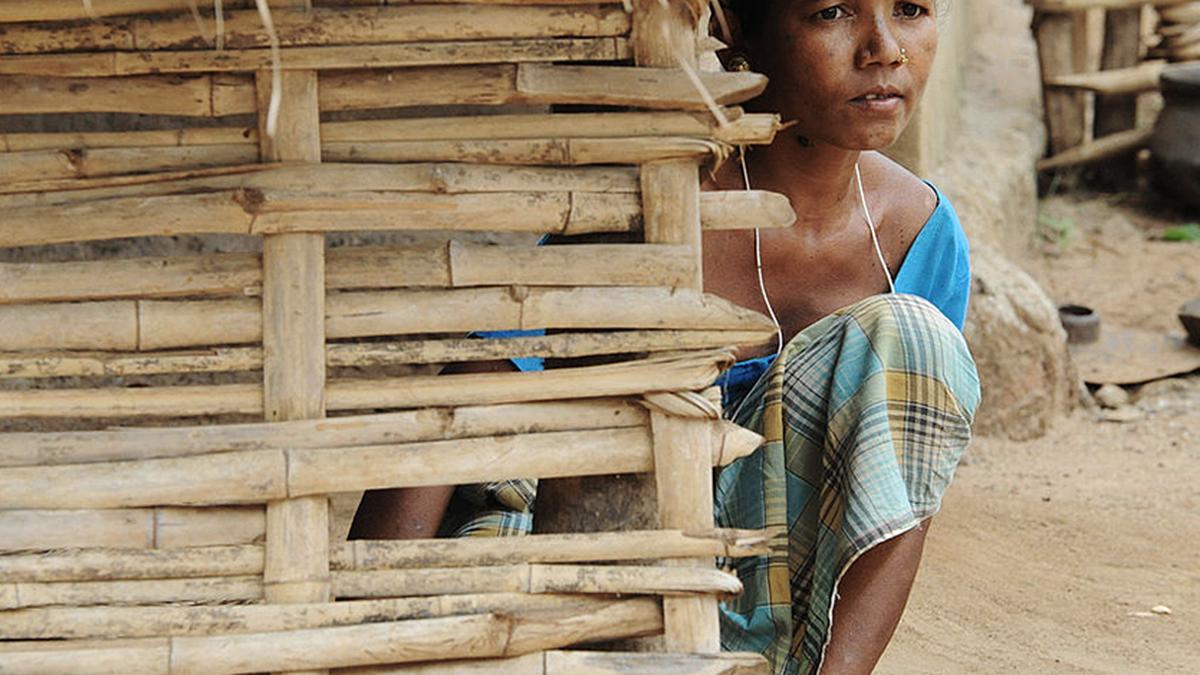
A Muria Gond woman from Chhattisgarh sits in a temporary hamlet in Khammam district of the then undivided Andhra Pradesh in 2009.
| Photo Credit: AFP via Getty Images
In 2005, around 50,000 Gond tribals were forced to migrate to then-undivided Andhra Pradesh (now parts of Telangana) when the Government of India embarked on the ‘strategic hamleting’ programme — an approach used in south Vietnam in the 1960s — to eliminate Maoists in Chhattisgarh. The project, however, was a failure. The tribals, who the government had relocated to roadside camps, have long gone back home to the deep forests, and while some, who could not go back in fear of Maoists, joined the security forces.
Some of these dislocated tribals are now the backbone of the current military successes of security forces against Maoists in Chhattisgarh. Many Maoists who have surrendered have also joined them. Unlike central paramilitary forces and local non-tribal police, these tribals know the language and terrain of the area, and have proven to be game-changers, especially for Home Minister Amit Shah, who has announced that the war against Maoists will be over by March 31, 2026.
Through the years
The Strategic Hamlet Program to fight communist revolutionaries is not new in India. Just after Independence, at the end of 1949, the new Government of India also shifted tribals from forests to roadside camps to fight the Telangana communist revolutionaries after the surrender of the Nizam. They had recruited hundreds of tribals as “special police constables” to fight the communist dalams, although they mostly possessed rudimentary weapons such as spears and axes and had no military training. One such special group of Koya tribals was the “Tiger Squad,” which had around 300 members.
The Strategic Hamlet strategy was more successful in Mizoram in the 1960s, where the government eventually reached a peace deal with the Mizo fighters. Much later, in 2019, when the same Mizo tribals started a fight with fellow Bru (Reang) tribals — causing thousands to flee to nearby Tripura — the Government of India came to their rescue with a Bru rehabilitation plan.
However, the government has not shown kindness towards the Gutti Koya tribals (as they are known in Andhra Pradesh and Telangana), who have been living precariously on illegally occupied forest lands for almost 20 years. In a recent meeting of the National Commission of Scheduled Tribes (NCST), a representative from the Chhattisgarh government stated that around 10,000 Gond tribals have been displaced to other States due to ongoing violence, and most of them do not want to return. Representatives from Telangana and Andhra Pradesh reported that they have 24,000 and 8,000 displaced tribals, respectively, from Chhattisgarh.
The NCST has ordered a proper survey of the displaced people in three months. The same order was issued in 2019, but Chhattisgarh said they could not conduct the survey then, due to the COVID-19 pandemic. The attitude of the Chhattisgarh government has slightly improved. In a written reply to a Congress MLA from Bastar a few years ago, the then Home Minister of Chhattisgarh stated in the Vidhan Sabha: “Because no tribal has been displaced due to ongoing violence in Bastar to other States, hence there is no question of their rehabilitation.”
In the absence of any national or international law for Internally Displaced People (IDPs) which India abides by, these tribals have been the subject of atrocities over the years — from forest officials, police, and even local tribals who view them as encroachers on their resources. Maoists have not allowed them to go back, and State authorities in Andhra Pradesh and Telangana are reluctant to treat them as tribals.
As per Clause 3.1(m) of the Forest Rights Act (FRA), if a tribal person was forced to vacate a forest land under her possession before the cut-off date of December 13, 2005, the State must provide her with alternative forest land. Many IDPs in Andhra Pradesh and Telangana have applied under this clause, requesting alternative forest land in these States. However, the Chhattisgarh government has been sitting on those applications for over five years. The clause does not say that alternative land cannot be given in a different State. Yet, Chhattisgarh has not raised the issue with either the Ministry of Tribal Affairs in Delhi or Andhra Pradesh and Telangana, despite repeated requests.
Under the 2019 Bru Rehabilitation Plan, Bru tribals were given the option of either going back to Mizoram or staying back in Tripura with lesser State support. Over the past 20 years, a new generation of Gutti Koya tribals has grown up in Andhra Pradesh and Telangana, but they have been denied State support as tribals because both governments treat them as “migrants who cannot be given tribal status.” In the NCST meeting, representatives of both States said, “We try to give support to these displaced tribals on humanitarian grounds, but we cannot do much. The Central Home Ministry should intervene here, as they have done in the case of other Internally Displaced People elsewhere.”
Most of the displaced tribals, mainly from the new generation, are attracted towards more economic opportunities available in Andhra Pradesh and Telangana and wish to stay. Telangana has taken over farmlands of many displaced tribals, planting trees there as part of a renewed effort to push them back to Chhattisgarh, and Andhra Pradesh has discouraged any efforts to build new houses in the forest by violently destroying them. Courts have occasionally offered relief to displaced tribals, but they are looking for a permanent settlement so that the new generation can live a life of dignity.
Shubhranshu Choudhary is author of Let’s call him Vasu: With Maoists in Chhattisgarh. He is also an active member of the New Peace Process there
Published – April 17, 2025 02:29 am IST
